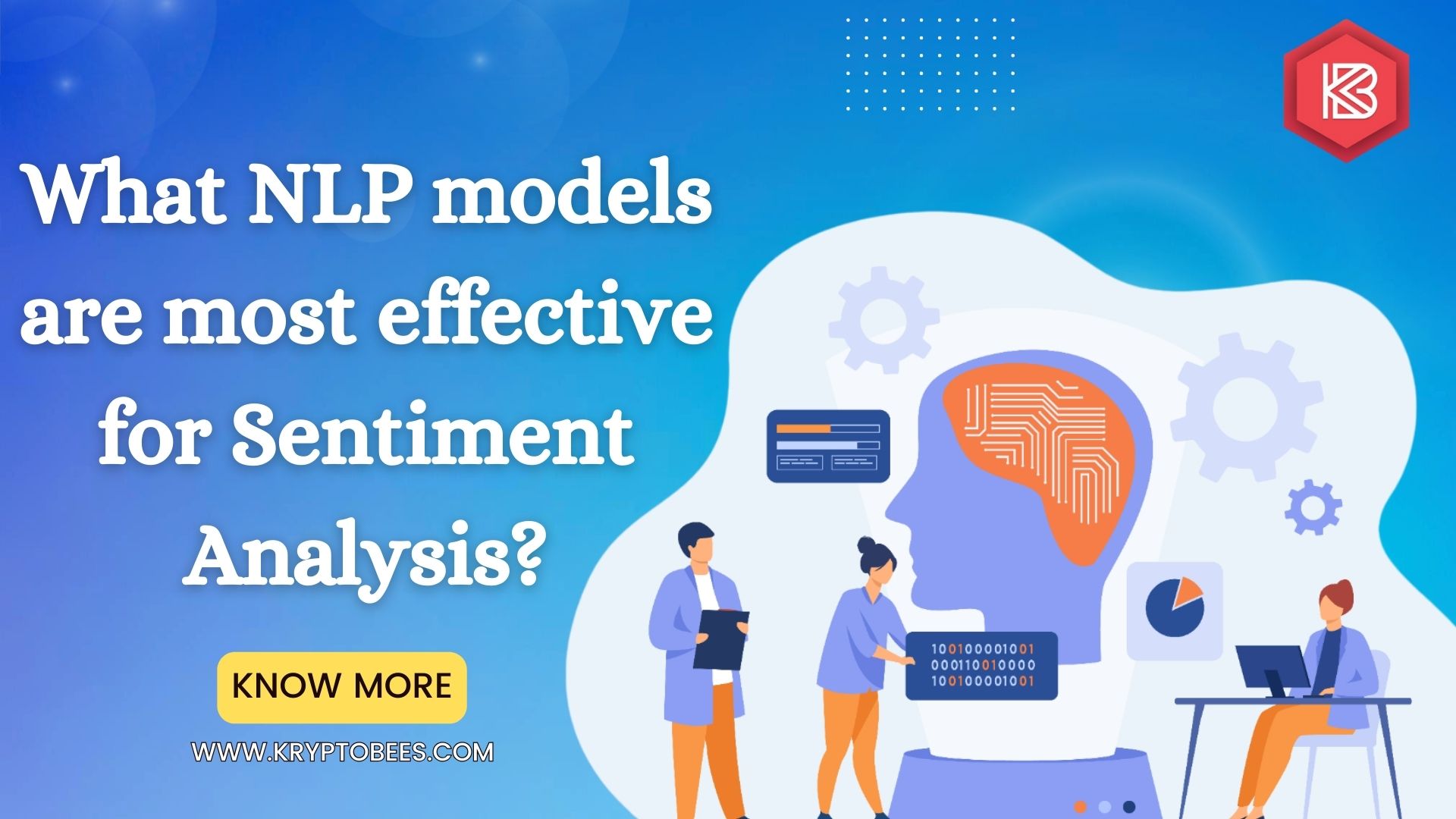What NLP models are most effective for sentiment analysis?

Sentiment analysis, a prominent facet of natural language processing (NLP), encompasses techniques for identifying and quantifying emotions within text data. Its application in businesses aids in automating the comprehension of customer feedback, assessing social media interactions, and potentially streamlining communication within customer care departments. Notably, NLP sentiment analysis have converged with economic research, appearing in esteemed journals.
Antweiler and Frank (2005) quantified internet stock message board content, while Algaba et al. (2020) surveyed sentiment method applications in economic surveys. Data scientists face choices in constructing sentiment classifiers—either from scratch, involving lexicon usage, human expert scoring, or data labeling, which is resource-intensive, or utilizing pre-trained models, a time-saving alternative with potential dataset limitations. This blog delves into four pre-trained sentiment classifiers—Vader, Happy Transformer, TextBlob, and Google Cloud NL API—exploring their functionalities and possibilities.
What is NLP- Natural Language Programming and it’s importance?
Sitting at the crossroads of computer science, artificial intelligence, and linguistics, Natural Language Processing (NLP) aims to empower computers to comprehend and execute tasks akin to human language. As voice interfaces and chatbots ascend, NLP stands pivotal in the 4th Industrial Revolution, fostering diverse AI applications, from straightforward to intricate.
– Retrieval tasks like search, spell-checking, and synonym finding.
– Web scraping for data like products, prices, dates, and locations.
– Services like machine translation, speech recognition, and personal assistants.
– Chatbots aiding in customer support, device control, and ordering.
– Tailoring online ads, and conducting sentiment analysis for marketing and finance.
– Detecting financial risks and fraudulent activities.
What makes Natural Language Processing (NLP) indispensable?
NLP – Natural Language Processing or natural language programming, stands as an essential component within sentiment analysis, employing computational techniques to decipher human language. Its operations encompass sentiment analysis, named entity recognition, part-of-speech tagging, and tokenization. NLP enables automated analysis of customer feedback, extracting precise sentiment information. Techniques involve text preprocessing, feature extraction, and model creation using methods like word embeddings or TF-IDF.
Leveraging machine learning and deep learning, natural language programming, aids in categorizing sentiments, providing valuable insights into customer preferences. This empowers businesses to analyze extensive feedback, grasp consumer sentiment, and drive data-informed decisions for enhanced customer satisfaction and business growth.
What does Sentiment Analysis actually mean?
Sentiment analysis involves identifying positivity or negativity in text, commonly employed by businesses to assess social data, monitor brand perception, and grasp customer insights. Also known as opinion mining, it aims to grasp the emotional tone in textual data—a subset of Natural Language Processing (NLP).
The core objective is categorizing text as positive, negative, or neutral, shedding light on consumer sentiments and brand image. However, challenges arise due to context dependency across cultures, making it intricate to decipher emotions. Moreover, nuances like sarcasm and irony pose complexities for accurate sentiment interpretation.
Various Types of Available Sentiment Analysis in NLP Language
Sentiment analysis delves beyond the polarity of its NLP language, identifying emotions, urgency, and intentions in text. Tailoring categories to match analysis needs allows nuanced interpretation of customer feedback. Below are popular sentiment analysis types.
Graded Sentiment Analysis
For businesses valuing precise polarity distinctions, expanding polarity categories can enhance analysis through:
- Extremely Positive
- Positive
- Neutral
- Negative
- Extremely Negative
Known as graded sentiment analysis, it refines interpretations, aligning, for instance, 5-star ratings with sentiments, from very positive to very negative.
Detecting Emotions
In sentiment analysis, emotion detection extends beyond polarity, capturing nuances like happiness, frustration, anger, and sadness. Methods involve lexicons or intricate machine-learning models. Yet, a challenge arises with lexicons; expressions of emotions vary. Words like “bad” or “kill,” usually depicting anger, might unexpectedly convey happiness in different contexts, complicating accurate analysis.
Aspect-based Sentiment Analysis
When examining text sentiments, aspect-based sentiment analysis identifies specific aspects or features described in a positive, neutral, or negative light. For instance, in a review stating, “The camera’s battery life is too short,” this approach discerns the negative sentiment about the product’s battery life specifically.
Multi-language sentiment analysis
Analyzing sentiments across multiple languages presents challenges, requiring extensive preprocessing and various resources. While online repositories offer sentiment lexicons, creating translated corpora or noise detection algorithms demands coding expertise. An alternative involves automatic language detection followed by custom sentiment analysis model training for classification in a preferred language.
The advantageous benefits of sentiment analysis include:
Data Sorting at Scale – Consider sorting through countless tweets or customer conversations manually—a daunting task. Sentiment analysis streamlines the processing of vast unstructured business data efficiently and affordably.
Analyses in Real Time – Sentiment analysis swiftly flags urgent matters: escalating PR crises or potential customer churn. Immediate detection empowers prompt action.
standard criterion – Assigning sentiment to text shows around 60-65% agreement, highly subjective due to personal experiences and beliefs. Implementing a unified sentiment analysis system ensures consistent criteria application, enhancing accuracy and yielding comprehensive insights for companies.
Some NLP-Natural Language Processing methods on sentiment analysis
In this introduction, we target the most common sentiment analysis: categorizing text as positive, neutral, or negative from various sources like social media, emails, or transcribed phone conversations. Two primary approaches, classical and deep learning, prevail for this analysis, both accessible through Python.
Classical methods entail feature and model definition,
- Identifying sentiments via methods like manual keyword dictionaries
- Creating ‘bag of words’
- Implementing TF-IDF strategies.
These strategies enable the sentiment analysis system to categorize text effectively, regardless of its origin, into distinct sentiment categories.
One approach to sentiment analysis involves employing a manually curated keyword dictionary, assuming specific words denote positive or negative emotions. For instance, in movie reviews, words like “great,” “super,” or “love” indicate positivity, while “hate,” “bad,” or “awful” imply negativity. This method counts occurrences of chosen words to construct feature vectors, training a classifier for sentiment analysis on each comment.
However, relying solely on predefined words poses limitations, potentially missing essential sentiments not encompassed in the dictionary. Herein, the concept of a bag of words emerges. Rather than considering a select set of words, this approach evaluates occurrences of all words in the language or dataset. Although this yields longer vectors, it ensures inclusion of crucial sentiments absent in manually constructed lists.
TF-IDF, an extension of the bag of words, modifies this by normalizing word occurrences based on their frequency in the dataset. This minimizes sensitivity to common words like “and” or “the,” prioritizing words more valuable for analysis.
After constructing feature vectors, the subsequent step involves model selection for predictions. Various models such as SVM, DecisionTree, RandomForest, or NeuralNetwork offer viable options, each with distinct strengths. The choice of model significantly impacts analysis, warranting thorough exploration of their potential within specific contexts, although details on this exceed this article’s scope.
Implementing these approaches often involves Python libraries like Scikit-Learn, enabling vector creation and sentiment analysis model training. Additionally, NLTK proves beneficial for data preprocessing tasks like removing stopwords and offers its pre-trained sentiment analysis model.
Overall, while sentiment analysis methods vary in complexity and scope, leveraging these strategies with appropriate models and libraries allows for robust sentiment assessment across diverse textual datasets.
For what purposes is sentiment analysis helpful?
In business, sentiment analysis proves invaluable, especially in evaluating customer feedback from online reviews regarding products or services. Beyond classifying feedback as positive, negative, or neutral, it facilitates grading systems and probes into opinions about specific aspects. Additionally, it unveils intentions and emotions behind customers’ expressions. Yet, you might wonder about its utility alongside existing feedback tools.
Absolutely! Incorporating sentiment analysis complements feedback collection methods, elevating comprehension of customer responses and fostering a competitive edge. For instance, it enables deeper insights into customer sentiments, leading to more targeted improvements or innovations. Its application transcends mere feedback analysis, paving the way for strategic enhancements aligning with customer needs and preferences.
- Brand Perception: Evaluate overall brand sentiment, tracking shifts in public attitude over time for a comprehensive brand overview.
- Customer Service Assessment: Analyze recorded helpdesk conversations to gauge client satisfaction and grade their experience.
- Employee Sentiment Analysis: Extend sentiment analysis beyond customers, examining employee feedback to understand their perceptions of work.
- Social Media Monitoring: Enhance marketing and product strategies by monitoring and analyzing online trends and their drivers.
- Competitor Analysis: Investigate competitor sentiment, identifying high-performing rivals and dissecting their success factors. Leverage this insight for strategic advantages in marketing, product innovation, and customer service initiatives.
Sentiment Analysis with Ethical Considerations in Mind
Ethical considerations in sentiment analysis encompass various essential domains, such as:
Bias and Fairness Issues: Biased sentiment analysis models can lead to unfair treatment. Addressing bias is crucial for equitable outcomes across demographics.
Fairness and Bias Concerns: Analyzing sentiments often involves handling personal data, prompting privacy concerns. Safeguarding user information, obtaining consent, and complying with privacy laws are essential.
Responsibility and Transparency: In sentiment analysis, transparency involves clear procedures and accountable choices, essential for justifiable results.
Ethical sentiment analysis hinges on addressing these issues, fostering trust, minimizing harm, and upholding fairness, privacy, openness, and accountability within organizations.
Parting Words
Understanding and dissecting emotional nuances within textual data makes sentiment analysis a pivotal tool. Its core elements encompass preprocessing, feature extraction, classification models, and evaluation methods. Future strides hinge on advancements in deep learning, interpretability, and ethical navigation. Unveiling commercial insights, sentiment analysis is crucial for diverse business facets like brand monitoring, product analytics, customer service, and market research. Integration into existing systems accelerates processes for brands, even at city-scale operations. Evolving beyond novelty, sentiment analysis is swiftly becoming an indispensable asset across industries. Its implementation not only offers fresh perspectives but also aids in comprehending customer behaviors and empowering teams for more effective outcomes.
Kryptobees, through its online platform, facilitates text analytics, machine learning, and data visualization. For assistance in constructing a sentiment analysis system tailored to your business requirement, explore Kryptobees Studio and request a demonstration.
 Discuss Project!
Discuss Project!